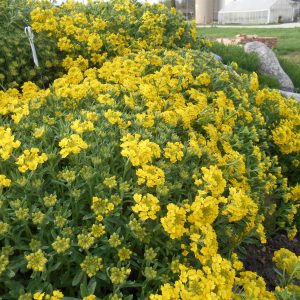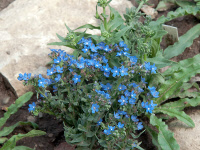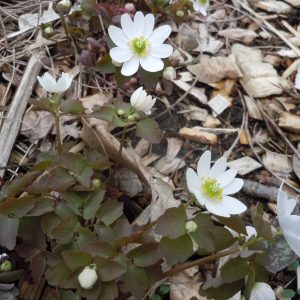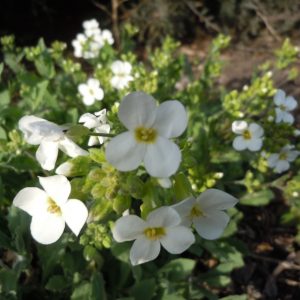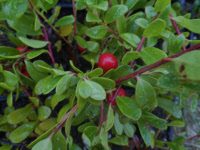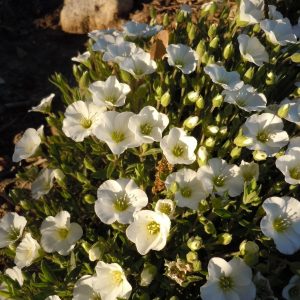Alpine, Rock, Miniature, Bonsai and Railroad Gardens
Showing 9–16 of 92 results
-
Allium senescens Corkscrew allium, German garlic, Greater mountain garlic Z 4-9
Lavender balls, up to 30 of them, atop thin, bluish, strap-like, twisting foliage – mid-summer day’s dream.
Lavender balls, up to 30 of them, atop thin, bluish, strap-like, twisting foliage – mid-summer day’s dream.
Size: 6-12” x 6-12”
Care: sun to part shade in well-drained to moist well-drained soil
Native: Siberia
Wildlife Value: attracts butterflies & bees, deer & rabbit resistantCultivated before 1753. According to Philip Miller’s 1768 Dictionary, “planted in gardens for the variety of their flowers.”
-
Alyssum wulfenianum syn. Alyssum ovirense Alpine alyssum, Madwort Z 3-9
Spring to early summer, clumps of sunny yellow blooms over gray foliage
OUT OF STOCK
Spring to early summer, clumps of sunny yellow blooms over gray foliage
Size: 4-6” x 12-18”
Care: sun in well-drained soil
Native: GermanyDescribed in Willdenow’s Enum. pl. suppl. Before 1814. Grown at the Agricultural Center in Beltsville Maryland in 1897.
-
Anchusa capensis Cape forget-me-not, Cape bugloss Z 6-9
Truest of blue flowers from summer through fall
OUT OF STOCK
Truest of blue flowers from summer through fall. Do you need to know anything else?
Reseeding annual in colder zones.
Size: 8” x 8”
Care: sun in well-drained to moist well-drained soil
Native: So. Africa.
Awards: Plant Select® Central Rocky Mountain regionCollected and introduced to Europe in 1794 by von Thunberg (1743-1828). Carl Peter von Thunberg, student of Linnaeus at Uppsala University in Sweden, made three trips to the Cape of Good Hope 1772-1775 where he collected about 1000 new species, Java and Ceylon (Sri Lanka) 1777 and 15 months in Japan where he befriended local doctors who gave him hundreds of plants new to Western horticulture. He succeeded Linnaeus as professor of medicine and botany at Uppsala and King Gustav beknighted him. Young Cape forget-me-not plants were eaten as a vegetable, Annals of the South African Museum, 1898. Louise Beebe Wilder loved this plant, effusing, “One of the prettiest (blue annuals) is the Cape Forget-me-not. Not one of its cerulean family boasts a purer blue and its summer-long period of bloom and indifference to drought make it a really valuable annual. It has also a sturdy habit of growth and sowing its hardy seeds freely it does its best to become a permanent resident.” Robinson called it “Remarkably fine…” The Garden 1873. The name Anchusa from anchousa paint used on skin.
-
Anemonella thalictroides Rue anemone, Windflower Z 4-7
Delicate white to pinkish cups in spring to mid-summer light up woodlands
OUT OF STOCK
Delicate white to pinkish cups in spring to mid-summer light up woodlands
Size: 8" x 8"
Care: part shade in moist well drained soil
Native: N.H through Ontario to Minn. Including, south to Florida & Kansas, Wisconsin native.First described by Linnaeus – 1753. Philip Miller grew this in 1768. Named Anemonella because the flowers resemble those of the Amenome and thalictroides because the leaves resemble the leaves of the Thalictrum, Meadowrue. Native Americans ate the tuberous root for food and made a tea from Rue anemone by steeping the root in water. The tea supposedly cured flu-like symptoms of diarrhea and vomiting.
-
Arabis caucasica syn. A. alpina subsp. caucasica Alpine Rock Cress (Bastard Tower Mustard, Miller 1768) Z 4-9
Late spring white four-petaled racemes. Perfect for a dry border or rock garden. Drought tolerant.
OUT OF STOCK
Late spring white four-petaled racemes. Perfect for a dry border or rock garden. Drought tolerant.
Size: 6-12”x 20” spreads
Care: Full sun well-drained soil, vigorous; cut back after flowering to make it full.
Native: Southern Europe and Mediterranean.
Size: Perfect for a dry border or rock garden. Drought tolerant.Arabis is Greek for Arabian. Cultivated in the U.S. since 1800’s.
-
Arcanthemum articum Arctic daisy Z 3- ?
Closely-packed groundcover like a rug of small, classic white daisies with yellow centers.
Closely-packed groundcover like a rug of small, classic white daisies with yellow centers.
Size: 6-18” x spreading
Care: sun to part shade in moist well-drained to well-drained soil
Native: Western Canada to Alaska, North-east Europe to Japan
Wildlife Value: drought tolerantBy 1735
-
Arctostaphylos uva-ursi Bearberry, Bear’s grape, Kinnikinnick Z 2-7
In spring fragrant, pinkish-white bell-shaped flowers, evergreen, glossy foliage and Marlboro red berries in fall.
OUT OF STOCK
“Dwarf ornamental shrub, ornamental in foliage, flowers and berry.” Rand 1866. In spring fragrant, pinkish-white bell-shaped flowers, evergreen, glossy foliage and Marlboro red berries in fall. Great for cascading over edge of wall or groundcover.
Size: 4” x 20” forms dense groundcover over time. Stems root to spread.
Care: sun to part shade in moist well-drained to dry, acidic soil. Needs watering until established. Best grown with protection from wind.
Native: No. America, Wisconsin native
Wildlife Value: Host for several butterfly species including Hoary Elfin, Brown Elfin and Freija Fritillary.
Awards: Cary Award Distinctive Plants for New EnglandKinnikinnick is Algonquin meaning “mixture.” Used as an ingredient in Native American smoke mixtures. For centuries leaves used to make medicinal tea as a tonic and diuretic in many parts of the world. Cheyenne drank the tea to cure back sprains. Some Native Americans used it to cure venereal disease, others to cure pimples and itching, peeling skin. Both Indians and colonists mixed leaves with tobacco for smoking. Collected by Meriwether Lewis on the Expedition.
-
Arenaria montana Sandwort, Mountain sandwort Z. 4-8
Perky white flowers mass over a mound of evergreen foliage, May – June. “…(A) very ornamental plant …(with) fine pure white and large flowers … the white flowers appear so thickly in early summer as to obscure the foliage.” Alpine Flowers for English Gardens 1911
OUT OF STOCK
Perky white flowers mass over a mound of evergreen foliage, May – June. “…(A) very ornamental plant …(with) fine pure white and large flowers … the white flowers appear so thickly in early summer as to obscure the foliage.” Alpine Flowers for English Gardens 1911.
Size: 4-6” x 8-12”
Care: sun to part shade in well-drained soil, shallow rooted so needs occasional water.
Native: Pyrenees Mountains – France & Spain
Awards: England’s Royal Horticultural Society Award of Merit.Collected before 1753. Arenaria from arena meaning “sand”, the condition for many of the species. Montana means “mountain.”


